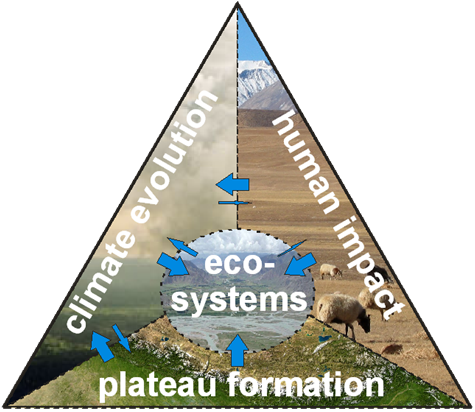| Unteregelsbacher, S; Hafner, S; Guggenberger, G; Miehe, G; Xu, X; Liu, J; Kuzyakov, Y: Response of long-, medium- and short-term processes of the carbon budget to overgrazing-induced crusts in the Tibetan Plateau, Biogeochemistry, Online First (2012), doi:http://dx.doi.org/10.1007/s10533-011-9632-9 | |
| Key words: Overgrazing , Land-use changes , Kobresia pasture , Root exudates , 13 C pulse labeling , CO 2 efflux from soil , Soil organic carbon , Soil respiration | |
| Abstract: The Kobresia pastures of the Tibetan Plateau represent the world’s largest alpine grassland ecosystem. These pastures remained stable during the last millennia of nomadic animal husbandry. How- ever, strongly increased herds’ density has promoted overgrazing, with unclear consequences for vegeta- tion and soils, particularly for cycles of carbon (C), nutrients and water. Vegetation-free patches of dead root-mat covered by blue-green algae and crustose lichens (crusts) are common in overgrazed Kobresia pastures, but their effect on C turnover processes is completely unknown. We tested the hypothesis that the crusts strongly affect the C cycle by examining: (i) the long-term C stock measured as soil organic matter content; (ii) medium-term C stock as dead roots; (iii) recent C fluxes analyzed as living roots and CO 2 efflux; and (iv) fast decomposition of root exudates. Up to 7.5 times less aboveground and 1.9 times less belowground living biomass were found in crust patches, reflecting a much smaller C input to soil as compared with the non-crust Kobresia patches. A lower C input initially changed the long-term C stock under crusts in the upper root-mat horizon. Linear regression between living roots and CO 2 efflux showed that roots contributed 23% to total CO 2 under non-crust areas (mean July–August 5.4 g C m -2 day -1 ) and 18% under crusts (5.1 g C m -2 day -1 ). To identify differ- ences in the fast turnover processes in soil, we added 13 C labeled glucose, glycine and acetic acid, representing the three main groups of root exudates. The decom- position rates of glucose (0.7 day -1 ), glycine (1.5 day -1 ) and acetic acid (1.2 day -1 ) did not differ under crusts and non-crusts. More 13 C, however, remained in soil under crusts, reflecting less complete decomposition of exudates and less root uptake. This shows that the crust patches decrease the rates of medium-term C turnover in response to the much lower C input. Very high 13 C amounts recovered in plants from non-crust areas as well as the two times lower uptake by roots under crusts indicate that very dense roots are efficient competitors with microor- ganisms for soluble organics. In conclusion, the altered C cycle in the overgrazing-induced crustose lichens and blue-green algae crusts is connected with strongly decreased C input and reduced medium-term C turnover. |

